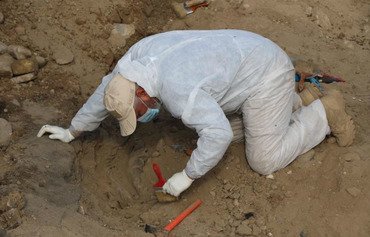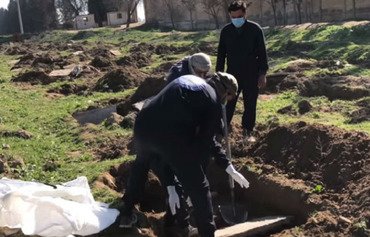Human Rights Watch (HRW) on Monday (May 4th) called for an investigation into a spectacular gorge in northern Syria that has been used as a dumping site for dead bodies over several years.
The 50-metre-deep hole in a desert area of al-Raqa province was under the control of the "Islamic State of Iraq and Syria" (ISIS) after it seized control of territory in Syria and neighbouring Iraq.
After the area was wrested from the group's control in late 2017 by the Syrian Democratic Forces (SDF), backed by the international coalition, HRW investigated the site.
The human rights watchdog found that bodies were dumped in the gorge during, but also after, ISIS rule.
"Al-Houta gorge, once a beautiful natural site, has become a place of horror and reckoning," said HRW Syria researcher Sara Kayyali.
The sinkhole, whose full depth is not visible from the edge, has always held near-mythical status in the area but was once a popular escape where residents would go for family picnics.
"Exposing what happened there, and at the other mass graves in Syria, is crucial to determining what happened to the thousands of people ISIS executed and holding their killers to account," she said.
One of more than 20 mass graves
It is not known how many bodies were dumped in al-Houta, one of more than 20 mass graves found in areas formerly controlled by ISIS.
HRW said the existence of the open mass grave came to light when an ISIS fighter took his laptop to a repair shop in the town of Tal Abyad.
A worker there wanted to expose ISIS crimes and copied the contents of the laptop, which included a video showing members of the extremist group throwing bodies into the pit.
HRW flew an unmanned aerial vehicle (UAV) into the gorge and spotted several bodies floating in the water filling the deepest section of the sinkhole.
"Based on the state of decomposition, the bodies were dumped there long after ISIS had left the area. The identities of those victims and their causes of death remain unknown," it said.
Speaking with Diyaruna in September 2016, former al-Raqa Media Office activist Majed Hassoun said that al-Raqa residents "know that [ISIS] dumps its victims into a deep gorge in the rocks known as al-Houta".
ISIS itself released a video in 2014 showing its fighters hurling bodies into the crevasse, he said.
Iraqi site yet to be fully investigated
A similar sinkhole known as al-Khafsa in northern Iraq is one of the most notorious mass graves uncovered to date, with unofficial estimates indicating it contains the remains of 25,000 bodies of ISIS victims.
In an HRW report published in March 2017, eyewitnesses from the area gave horrific accounts of victims being killed and thrown into the naturally occurring sinkhole, located eight kilometres south of western Mosul.
Eyewitnesses said they had seen multiple mass executions conducted at the sinkhole, sometimes on a weekly basis, beginning in June 2014 and continuing until May or June 2015.
In its new report, HRW said al-Khafsa also had yet to be fully investigated.

![ISIS produced video footage showing its fighters throwing the bodies of its victims into al-Houta gorge in Syria's al-Raqa province. [Photo courtesy of Mohammed al-Abdullah]](/cnmi_di/images/2020/05/04/23869-raqa-houta-gorge-600_384.jpg)






